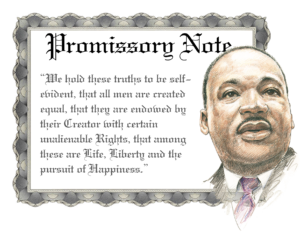Today America celebrates Martin Luther King, Jr. Day. It is always observed on the third Monday of January each year, which is around the time of King’s birthday, January 15. Although the holiday is named in honor of the man who gave up his life promoting civil rights, its observance recognizes the importance of human rights and dignity — causes about which Dr. King was passionate. In his famous “I have a dream” speech, delivered from the steps of the Lincoln Memorial in 1963, Dr. King said:
“In a sense we have come to our nation’s capital to cash a check. When the architects of our republic wrote the magnificent words of the Constitution and the Declaration of Independence, they were signing a promissory note to which every American was to fall heir. This note was a promise that all men, yes, black men as well as white men, would be guaranteed the unalienable rights of life, liberty, and the pursuit of happiness.”
The struggle for equality, be it racial or gender equality, is one that must be continually pursued. Human capital is too precious to squander and diversity not only adds spice to life, but, as Alaina Love, President of Purpose Linked Consulting, argues, it can be a strategic advantage for businesses as well. [“Diversity as a Strategic Advantage,” Bloomberg BusinessWeek, 10 May 2010] She wrote:
“Since the establishment of affirmative action in the early 1960s, organizations have struggled with shifting their focus on diversity from a numbers exercise of quota achievement to leveraging the benefits that can be derived from employees with different backgrounds and perspectives in a way that provides a commercial advantage. While we’ve seen startling advances in technology and radical shifts on the political, cultural, and demographic fronts over the past 50 years, the utilization of diverse talent in organizations has not kept pace. Leaders often intuitively understand the advantage of a diverse workforce, especially in today’s global economy, yet many organizations grapple with how to develop and apply diversity principles in a way that will affect revenue and market position, as well as reputation.”
Love believes that companies should consciously seek diversity rather than leave it to chance. That’s an argument that still has its critics; most of whom believe that workplace qualifications and skills are the only fair metrics that should be used in hiring. Love continued:
“For companies to capitalize successfully on diversity, they must develop a robust and comprehensive strategic framework that not only considers how to attract and retain diverse employees but also is anchored in a culture of inclusion. In the 16 years I have consulted to multinational companies on issues of leadership, including diversity, some common characteristics have emerged among companies that utilize diversity as a strategic lever for growth and innovation.”
In previous posts on innovation and creativity, I have stressed the importance of teams that include participants from varied backgrounds and disciplines. The more perspectives from which a challenge can be viewed the better the chances of coming up with an innovative solution. Love’s diversity argument is an extension of Frans Johansson calls the “Medici Effect.” Love has identified five characteristics that she believes distinguishes companies that have made diversity a strategic advantage. The first characteristic deals with leadership:
“1. A Prepared Leadership and Workforce — Leaders and managers of cutting-edge companies are exposed to training and development that enhance their understanding and valuing of differences and allows them to examine the tenets of race and ethnicity that have shaped their perspectives on diverse groups. Accountability is key in these organizations, so diversity goals are built into annual objectives and progress is measured.”
The second characteristic deals with recruitment and retention.
“2. Sophisticated Programs to Attract, Engage, Develop, and Retain Diverse Talent — The best companies actively seek diverse talent and foster relationships with potential recruits at an early stage through internships and, after hiring, through talent-development programs. The road to career success is clear and unambiguous, with required competencies and skills for every position widely communicated across the organization. Management invests in nurturing relationships with diverse individuals who might be recruited to their organization. Also, top companies require that the composition of their boards and management committees reflect their goals, which provides added credibility with potential new hires.”
Love makes two really important points. The first point is that a company’s standards (i.e., its required competencies and skills) don’t need to be compromised in order to have diverse workforce. The second point is that companies should be willing to test and train their employees to ensure that each employee has fair playing field. Love’s third characteristic involves analysis and follow through.
“3. Measuring and Demanding Inclusion — In companies that leverage diversity, the process does not end with recruitment; it shifts to including diverse views and perspectives in developing business strategy and meeting challenges. How well diverse groups are included across the organization in both formal and informal networks is examined and efforts are made to enhance those opportunities.”
Love’s next characteristic is also very important. It’s about giving everyone an opportunity to be heard.
“4. Giving Everyone a Voice — The best organizations recognize that beyond race, gender, ethnicity, and sexual orientation, diversity also applies to thought, skill, and passions. Differences are appreciated, but the corporate culture provides space for challenging differences in search of the best business solutions. In this environment, people are able to advocate their point of view passionately, even if it differs from the status quo. Ultimately, diversity includes everyone, regardless of background.”
It does a company no good to assemble a diverse team if that diversity is not exploited in some meaningful way. People need to know that their opinions will be heard and respected; but, they should also know that their opinions and ideas must compete with those of others before they are implemented. Love’s final characteristic involves corporate culture.
“5. Diversity Is a Core Operating Principle — With the realization that diversity can bring about competitive advantage, partnering occurs among diverse groups across all functional areas and is anchored by common goals. This reduces silo mentality and allows for increased creativity and innovation. Beyond being a moral imperative, diversity in top companies is a key plank in the platform for business success.”
Long-time readers of this blog know that I’m a firm believer that corporate silos need to be reduced if a company is going to achieve greatness. Breaking down barriers and fostering communication can only result in more and better solutions to emerging challenges. Love notes that “IBM is leveraging diversity through affinity channels as a mechanism to encourage innovation at every level.” She explained:
“When Systems Management Specialist Pam Nesbitt filed her first patent in 2003, she became acutely aware of how few women at IBM were patenting their work. ‘The company has Invention Development Teams [composed] of volunteers who help individual inventors navigate the patent disclosure process,’ Nesbitt explains. ‘I noticed that there were almost no women on these teams and none submitting patents.’ Sure that she could change this trend, Nesbitt contacted 20 female co-workers who were in technical roles and founded IBM’s Women Inventor’s Community. The group, which was formed in late 2006, now has more than 1,000 women worldwide. Collectively, these women have submitted nearly 900 patent disclosures internally and have been granted almost 300 patents.”
By any measure, those are impressive numbers. Love wrote, “Not all large companies are as advanced in their strategic application of diversity, but some are recognizing the advantage that a shift in focus might provide.” Love concluded:
“As organizations embrace the power of diversity to drive business results, it clearly positions them for growth in a flatter world economy, where the composition and complexion of the workforce and customer base is increasingly shifting. Changing the lens through which diversity is viewed moves leadership perspectives on the issue from tacit compliance with government mandates to true recognition that diversity is a partner in business success. Organizations that are not making the most of their diverse talent will find themselves in the unenviable position of watching competitors take the lead.”
Near the end of Dr. King’s “I have dream” speech, he said, “I have a dream that my four little children will one day live in a nation where they will not be judged by the color of their skin but by the content of their character.” He was not asking for favors but for fairness. Had he been alive to celebrate his 82nd birthday this year, I suspect that he would agree with most of what Ms. Love wrote last year. He believed in diversity. He believed the country would be stronger and better once men and women of every race, creed, and color started working together towards the same goals. Business leaders need to understand that their businesses will be stronger and better if they break down barriers, embrace diversity, and foster better communication.




